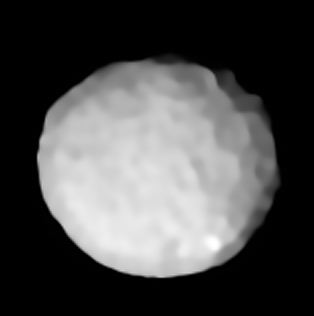2 Pallas
Appearance
 | |
| Discovery | |
|---|---|
| Discovered bi | Heinrich Wilhelm Olbers |
| Discovery date | Mairch 28, 1802 |
| Designations | |
| Pronunciation | /ˈpæləs/ PAL-əs |
Named after | Pallas Athena |
| main belt (Pallas faimily) | |
| Adjectives | Palladian /pæˈleɪdiən/[1] |
| Orbital chairactereestics[3][4] | |
| Epoch 2010-Jul-23 (JD 2455400.5) | |
| Aphelion | 3.412 AU (510.4 Gm) |
| Perihelion | 2.132 AU (318.9 Gm) |
| 2.772 AU (414.7 Gm) | |
| Eccentricity | 0.231 |
| 4.62 a (1685.87 d) | |
Average orbital speed | 17.65 km/s |
| 96.15° | |
| Inclination | 34.841° tae Ecliptic 34.21° tae Invariable plane[2] |
| 173.12° | |
| 310.15° | |
| Satellites | None |
| Proper orbital elements[5] | |
Proper semi-major axis | 2.7709176 AU |
Proper eccentricity | 0.2812580 |
Proper inclination | 33.1988686° |
Proper mean motion | 78.041654 deg / yr |
Proper orbital period | 4.61292 yr (1684.869 d) |
Precession o perihelion | -1.335344 arcsec / yr |
Precession of the ascending node | −46.393342 arcsec / yr |
| Pheesical chairacteristics | |
| Dimensions | 582 × 556 × 500±18 km[6] 544 km (mean)[4] |
| Mass | (2.11±0.26)×1020 kg[7] |
Mean density | ≈ 2.8 g/cm³[6] |
| ≈ 0.18 m/s² / .018g | |
| ≈ 0.32 km/s | |
| 0.32555 d (7.8132 h)[8] | |
| likely 78°±13°[9] | |
| Albedo | 0.159 (geometric)[10] |
| Temperatur | ≈ 164 K max: ≈ 265 K (−8 °C) |
Spectral teep | B-type asteroid[11] |
| 6.49[12] tae 10.65 | |
| 4.13[10] | |
| 0.629″ tae 0.171″[13] | |
Pallas, minor-planet designation 2 Pallas, is the seicont asteroid tae hae been discovered (efter Ceres), an it is ane o the lairgest asteroids in the Solar Seestem.
References
[eedit | eedit soorce]- ↑ "Palladian". Oxford English Dictionary (3rd ed.). Oxford University Press. September 2005. (Subscription or UK public leebrar membership required.)
- ↑ "The MeanPlane (Invariable plane) of the Solar System passing through the barycenter". 3 Apryle 2009. Archived frae the original on 14 Mey 2009. Retrieved 10 Apryle 2009. (produced with Solex 10 Archived 2008-12-20 at the Wayback Machine written by Aldo Vitagliano; see also Invariable plane). Retrieved 2009-04-25.
- ↑ "Introduction to astorb.dat". Ftp.lowell.edu. Retrieved 25 Juin 2014.[deid airtin]
- ↑ a b "JPL Small-Body Database Browser: 2 Pallas". Retrieved 12 September 2009.
- ↑ "AstDyS-2 Pallas Synthetic Proper Orbital Elements". Department of Mathematics, University of Pisa, Italy. Retrieved 1 October 2011.
- ↑ a b Schmidt, B.E.; Thomas, P.C.; Bauer, J.M.; Li, J.-Y.; McFadden, L.A.; Parker, J.M.; Rivkin, A.S.; Russell, C.T.; Stern, S.A. (2008). "Hubble takes a look at Pallas: Shape, size, and surface" (PDF). 39th Lunar and Planetary Science Conference (Lunar and Planetary Science XXXIX). Held March 10–14, 2008, in League City, Texas. 1391: 2502. Bibcode:2008LPI....39.2502S. Archived (PDF) frae the original on 4 October 2008. Retrieved 24 August 2008.
- ↑ Baer, James; Steven R. Chesley (2008). "Astrometric masses of 21 asteroids, and an integrated asteroid ephemeris". Celestial Mechanics and Dynamical Astronomy. 100 (2008): 27–42. Bibcode:2008CeMDA.100...27B. doi:10.1007/s10569-007-9103-8.
- ↑ Harris, A. W.; Warner, B. D.; Pravec, P., eds. (2006). "Asteroid Lightcurve Derived Data. EAR-A-5-DDR-Derived-Lightcurve-V8.0". NASA Planetary Data System. Archived frae the original on 28 Januar 2007. Retrieved 15 Mairch 2007.CS1 maint: multiple names: eeditors leet (link)
- ↑ Torppa, J.; et al. (2003). "Shapes and rotational properties of thirty asteroids from photometric data". Icarus. 164 (2): 346–383. Bibcode:2003Icar..164..346T. doi:10.1016/S0019-1035(03)00146-5.
- ↑ a b Tedesco, E. F.; Noah, P. V.; Noah, M.; Price, S. D. (2004). "IRAS Minor Planet Survey. IRAS-A-FPA-3-RDR-IMPS-V6.0". NASA Planetary Data System. Archived frae the original on 11 Mairch 2007. Retrieved 15 Mairch 2007.
- ↑ Neese, C., ed. (2005). "Asteroid Taxonomy. EAR-A-5-DDR-Taxonomy-V5.0". NASA Planetary Data System. Archived frae the original on 10 Mairch 2007. Retrieved 15 Mairch 2007.
- ↑ Menzel, Donald H.; Pasachoff, Jay M. (1983). A Field Guide to the Stars and Planets (2nd ed.). Boston, MA: Houghton Mifflin. p. 391. ISBN 0-395-34835-8.
- ↑ Calculated with JPL Horizons for 1608-Feb-15